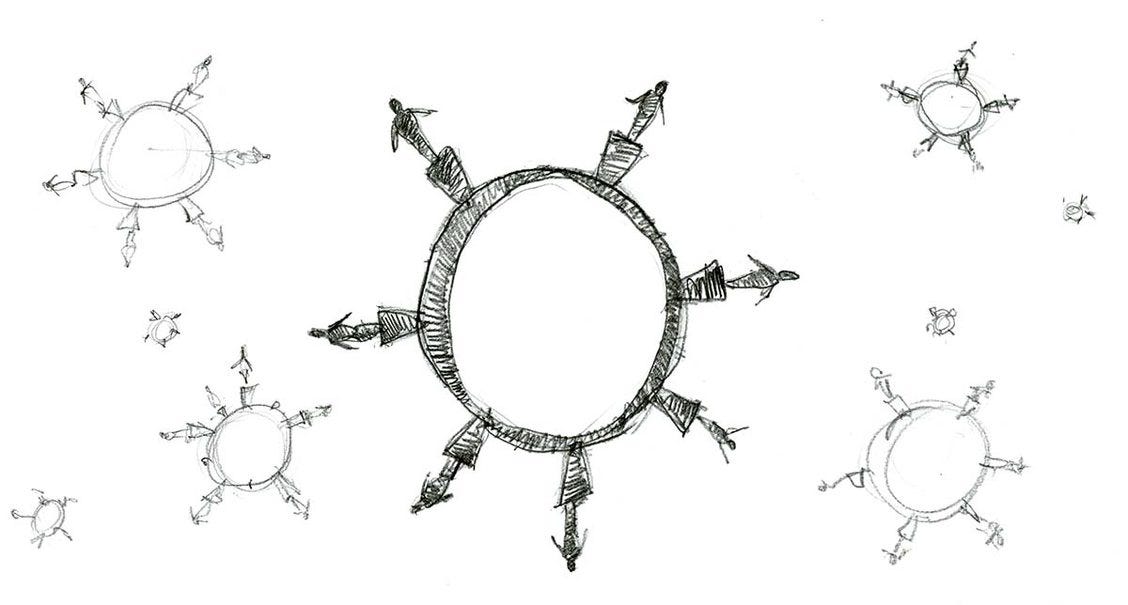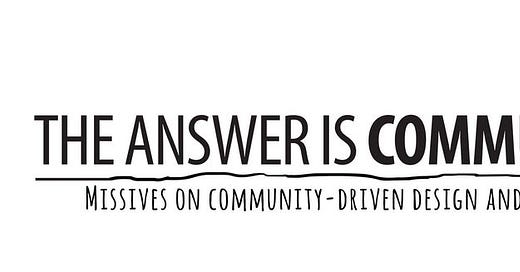The Answer is Community : Welcome!
View this email in your browser

Hey there! I started a blog!
Whaaa?
Yup. I started a blog
After fifteen years of working directly with communities to craft public spaces, I felt there was a chance others would find valuable what I had to say. I’m calling it “The Answer is Community.” The title is based on one of my favorite quotes by Dorothy Day that touches on the deeply human drive for connection that underpins all community-based organizing and practice, no matter the discipline or context:
“We have all seen the long loneliness…and we have found that the answer is community.”
I’m planning on writing about a bunch of things of interest to me:
The human-centered drive to connect and belong and the value of place-based communities
The power of community driven design to bring people together
Best practices of inclusive and decisiveness community engagement
Commentary on local and national events vis-a-vis these topics
If you want to know more, check out this link.
You are getting this first email blast because I am wagering that you might be interested or nice enough not to go right to the unsubscribe button. It’s okay if you do - I won’t be offended. I know we are all busy and need to make tough decisions to manage our media intake. There should be an unsubscribe button down below, er… I think. I’m still trying to figure out all these new tools!
Otherwise, what would be really great is if you could share this email widely with anyone you know who might be interested. And encourage them to sign up to get my twice-monthly posts directly to their mailbox (like I already did for you!).
So, without further ado, my first post is below. It’s a little longer and stiffer than I would like, but I hope you can bear with me as I find my written voice and move towards greater brevity, humor and poignancy. Let me know what you think!
Ok, now, where is that send button…?
Eric Higbee
Covid and Community Part I: Headwinds for Engagement
Covid is creating new challenges for community engagement, but is ultimately providing cover for community processes that fall short of their potential.

No more than five people. In Washington State that’s the maximum number of people who can get together at any one time and place in Washington State.
If you didn’t think community engagement work was already challenging, these types of restrictions on in-person gatherings are creating headwinds for many professionals and communities who conduct community engagement work.
For most this means an increased reliance on digital tools and virtual meetings. I’ve been keeping an eye on how folks have been adapting these tools for their community engagement work during COVID, including observing virtual meetings and events. My observations are largely in the arena where I practice professionally - engaging communities in the design and planning of public spaces.
Sadly, despite great intentions and noble efforts, most of what I’ve seen so far has been variations of the lighter forms of community engagement, lacking in techniques and outcomes that fulfill the true potential of engagement - that is fostering authentic dialogue, connection and ownership amongst community members.
The true potential of engagement is fostering authentic dialogue, connection and ownership amongst community members.
But ultimately this isn’t really much different from what normally is done under the guise of engagement. In fact, I would posit that Covid is providing cover for agencies and professionals to conduct community processes where they are already most comfortable - at arm's length.
Let me explain.
Checkbox vs Deep Engagement
There is a range of outcomes and goals when working with communities. On one end of the spectrum is what I call “Checkbox Engagement” - community engagement, often conducted by governing agencies, that does “outreach” and collects “feedback” from community members.
Checkbox Engagement often employs techniques that are considered standard fare in an engagement toolkit - surveys, voting, tabling, etc. And while yes, under the right circumstances these tools can be useful and valuable, most of these techniques are conducted in isolated channels of one-way interactions between the contributor and the client/consultant. Essentially, there is no listening or exchanges between community members.
On the other end of the community engagement spectrum is what I call “Deep Engagement” - community engagement that aspires to create connections between people and the places where they live. This happens when people listen to each other, get to know each other, exchange ideas and build off each others’ contributions. Deep Engagement cultivates a sense of a greater good, collective effort, and place-based belonging.
The world desperately needs more of the connection-making that comes from Deep Engagement, and every community process that does not aspire to this potential is a tragic missed opportunity
I see Deep Engagement happening naturally and most often in grassroots bottom-up organizing efforts. I see it less often in top-down government agency-led work. Frankly, I have found that most agencies are deterred by the challenges and potential loss of control that comes from truly engaging communities, and by default place comforting boundaries around the scope of community engagement processes to prevent them from being too effective. In other words, just enough to check the box.
My personal and professional bias is that the world desperately needs more of the connection-making that comes from Deep Engagement, and every community process that does not aspire to this potential is a tragic missed opportunity.
Deep Engagement in Covid-Online World
So how does one achieve elements of Deep Engagement in the absence of face-to-face gatherings in this time of COVID?
One of the primary challenges is that humans are evolutionarily wired to form connections through in-person contact. It’s just the way we are built (More on this on my next post!). The best techniques for Deep Engagement leverage face-to-face interactions and are hard to implement virtually. Sorry Zoom/Skype/Teams: you are a wonderful stop-gap, but you will never be able to replicate what happens, for example, when we gather together, look each other in the eye, and share our visions of the future.
However, there are some ways to adapt aspects of a well-run community process to the digital world.
Sorry Zoom/Skype/Teams: you will never be able to replicate what happens, for example, when we gather together, look each other in the eye, and share our visions of the future.
Here is one idea: one of the techniques we commonly employ in our community meetings is to put all the contributed ideas onto a shared display, typically on a flip chart or a white board. This allows a participant to see their contribution in the context of everyone else’s contributions, loosening the grip on “my idea” and transmuting it into one component of a rich sea of potential. With the ideas displayed for everyone to see, other ideas start to bounce around and build off each other, and the meeting becomes a collective process of self-discovery. It becomes “our work”. It’s a subtle but very profound approach, and I think something similar could be done in an online format.
I rarely see Deep Engagement during normal times, and have yet to see it done during Covid-times. Despite my critique, I am confident there are people out there doing amazing work.
Do you have any good examples, dear reader, of deep engagement translated into an online format? What have you seen successfully foster authentic dialogue, connection, and ownership amongst community members?


Never miss a story! Sign up for our list!
Copyright (C) *|CURRENT_YEAR|* *|LIST:COMPANY|*. All rights reserved.
*|IFNOT:ARCHIVE_PAGE|**|LIST:DESCRIPTION|**|END:IF|*
*|IFNOT:ARCHIVE_PAGE|**|HTML:LIST_ADDRESS_HTML|**|END:IF|*
Update Preferences | Unsubscribe
*|IF:REWARDS|* *|HTML:REWARDS|* *|END:IF|*




